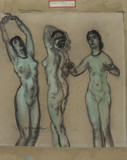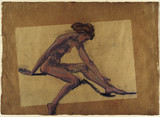Arthur Bowen Davies’s art was an important link between nineteenth-century symbolist-romantic trends and early twentieth-century modernism. He received his first art instruction at an early age from Dwight Williams (18561932) and attended the school of the Art Institute of Chicago in the late 1870s and early 1880s. In 1886 he settled in New York, enrolled in the Art Students League, and began supporting himself as an illustrator for magazines such as The Century. In 1893 he exhibited for the first time at the National Academy of Design and with his first solo exhibition in 1896 began his long and fruitful association with the Macbeth Gallery. In the mid-1890s he traveled throughout Europe three times, studying ancient, old master, and contemporary art. His oil paintings of the 1890s are realistic scenes of figures in contemporary dress, usually women and children, presented in outdoor settings. His later paintings became more imaginative, reflecting the mingling of influences from such sources as ALBERT PINKHAM RYDER, Pierre-Cécile Puvis de Chavannes (1824-1898), Ferdinand Hodler (1853-1918), and Arnold Böcklin (1827-1901).
Around 1900 Davies began to focus on the nude as his art became infused with classicism and took on a poetic, even visionary quality, with themes suggesting mythological and literary allusions. Around this time he met ROBERT HENRI and through this association participated in the landmark exhibition of The Eight at the Macbeth Gallery in 1908. He continued to travel extensively in the United States and Europe. By 1905 his marriage to Dr. Virginia Merriweather Davies had disintegrated and he began living secretly with Edna Potter as Mr. and Mrs. David A. Owen. Potter was a dancer, and this association was crucial in furthering Davies’s fascination with the motif of the figure in dancelike poses.
As principal organizer of the Armory Show Davies was instrumental in determining the exhibition’s modernist orientation. The exhibition also briefly affected his art as he painted in a more modernist style from 1913 to about 1915, giving his nudes an overlay of colored planes inspired by cubism and synchromism. He returned to his more classical style in the late teens but began to experiment with different mediums, including sculpture, prints, and tapestry. In the 1920s during visits to Italy he worked more with watercolor, creating his most lyrical landscapes in soft colors.
During the last decade of his life he became an enthusiastic follower of the zoologist Gustav Eisen and his theory of inhalation, applying it to his depiction of the nude. Davies was the advisor of Lillie P. Bliss, helping her amass one of the foremost collections of modern art, which later became the core of the collection of the Museum of Modern Art in New York.
BIBLIOGRAPHY
Washington, D.C., Phillips Memorial Gallery, Arthur B. Davies: Essays on the Man and His Art, Phillips Publications no. 3 (Cambridge, Mass.: Riverside Press, 1924), with essays by Duncan Phillips, Dwight Williams, Royal Cortissoz, and others § Index 20th Cent. Artists 4 (February 1937): 385-400; reprint, pp. 679-94 § Brooks Wright, The Artist and the Unicorn: The Lives of Arthur B. Davies (1862-1928) (New City, New York: Historical Society of Rockland County, 1978), with bibliography § Joseph S. Czestochowski, The Works of Arthur B. Davies (Chicago: University of Chicago Press, 1979), with foreword by Mahonri Sharp Young, catalogue raisonné, bibliography § Boston, Institute of Contemporary Art, and others, Dream Vision: The Work of Arthur B. Davies, exh. cat., 1981, with essays by Stephen S. Prokopoff, Linda Wolpert, Garnett McCoy, and others.




